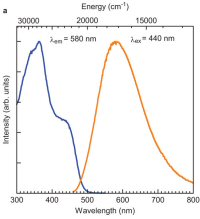A research group has fabricated what it claims is the world's first LED that emits warm-white light using a single phosphor. A group of researchers at the University of Georgia, together with other collaborators, have developed a new phosphor that can be used to create warm-white (<4000K) LED light emission without the need for a second phosphor.

The results were reported in a paper entitled “New yellow Ba0.93Eu0.07Al2O4 phosphor for warm-white LEDs through single-emitting-center conversion,” published in the journal “Light: Science and Applications.”
Most warm-white phosphor-converted LEDs use a combination of a blue-emitting LED together with at least two phosphors. This ensures there is sufficient emission in the red part of the spectrum to provide a correlated color temperature (CCT) below 4000K.
The researchers reported a new Ba0.93Eu0.07Al2O4 phosphor that has an orthorhombic lattice structure and exhibits a broad yellow photoluminescence band with sufficient red spectral component.

Warm-white emission with a CCT below 4000K and color rendering index (CRI) above 80 were readily achieved when combining the Ba0.93Eu0.07Al2O4 phosphor with a blue light-emitting diode (440–470 nm).
"Right now, white LEDs are mainly used in flashlights and in automotive lamps, but they give off a bluish, cool light that people tend to dislike, especially in indoor lighting," said senior author Zhengwei Pan, an associate professor in the department of physics in the UGA Franklin College of Arts and Sciences and in the College of Engineering. "Our material achieves a warm color temperature while at the same time giving highly accurate color rendition, which is something no single-phosphor-converted LED has ever been shown to do."
Using a single phosphor removes the need to ensure that two or more phosphors are combined in the correct ratio. Also, each phosphor in the mixture is likely to respond differently to temperature variations.
Pan said that, although his team's results are promising, there is still work to do to improve the procedure to synthesize the phosphor. Also, the efficiency of the new material is much lower than that of today's bluish-white LEDs. About the Author Tim Whitaker is an Editorial Consultant with LEDs Magazine.





